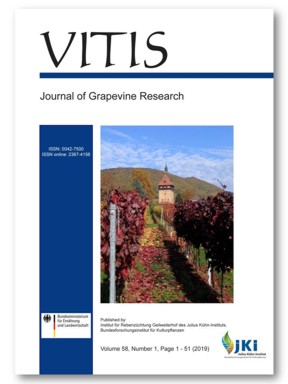Improving fruit anthocyanins in 'Cabernet Sauvignon' by shifting fruit ripening and irrigation reduction post veraison in warmer region
DOI:
https://doi.org/10.5073/vitis.2019.58.23-31Keywords:
anthocyanins; temperature; irrigation reduction; warmer region.Abstract
In warmer regions, forcing vines to regrow and shifting fruit ripening to the cooler portion of the growing season can increase the concentration of total fruit anthocyanins (TFA) in red winegrapes, but the effect on anthocyanin composition remains unclear. Additionally, irrigation reduction post veraison was reported to improve fruit anthocyanins in cool and temperate regions with low precipitation, whereas this response has not been previously examined in forced vines grown in dry and warm regions. Experiments were conducted with 'Cabernet Sauvignon' (Vitis vinifera L.) over two consecutive years in Fresno, California, to investigate the effect of shifting fruit ripening on the concentration and composition of fruit anthocyanins as well as the influence of post-veraison irrigation reduction on fruit anthocyanins of forced vines. Vines under conventional practices (non-forced) were used as the control. Forcing treatment included removing primary leaves, clusters, and laterals, as well as hedging primary shoots, in mid-June. Control vines were irrigated at 80 % crop evapotranspiration (ETC) post veraison, whereas forced vines were irrigated at 40, 60, 80, or 100 % ETC post veraison. Results suggest that forcing vines to regrow and shifting fruit ripening led to a significant increase of TFA, primarily non-acylated anthocyanins, during fruit ripening and at harvest over two years. Forcing treatment also altered composition of fruit anthocyanins at harvest, with increased proportions of TFA comprised by the glucosides of delphinidin and petunidin but the decreased proportion of the glucosides of malvidin. This study demonstrates that forcing vines to regrow and shifting fruit ripening in the warmer region can lead to a more balanced profile of fruit anthocyanins, with improved non-acylated derivatives and altered relative abundance of the glucosides of five anthocyanidins. Reducing irrigation post veraison, however, had only a minor effect on fruit anthocyanins in forced vines.
Downloads
Published
Issue
Section
License
The content of VITIS is published under a Creative Commons Attribution 4.0 license. Any user is free to share and adapt (remix, transform, build upon) the content as long as the original publication is attributed (authors, title, year, journal, issue, pages) and any changes to the original are clearly labeled. We do not prohibit or charge a fee for reuse of published content. The use of general descriptive names, trade names, trademarks, and so forth in any publication herein, even if not specifically indicated, does not imply that these names are not protected by the relevant laws and regulations. The submitting author agrees to these terms on behalf of all co-authors when submitting a manuscript. Please be aware that this license cannot be revoked. All authors retain the copyright on their work and are able to enter into separate, additional contractual arrangements.



